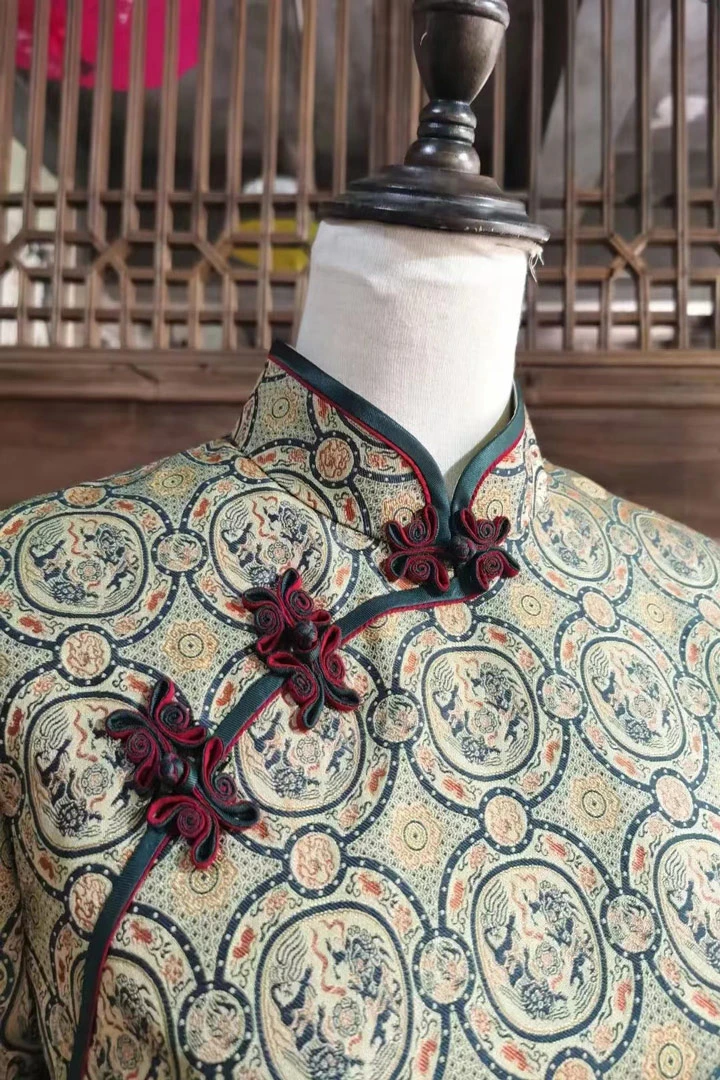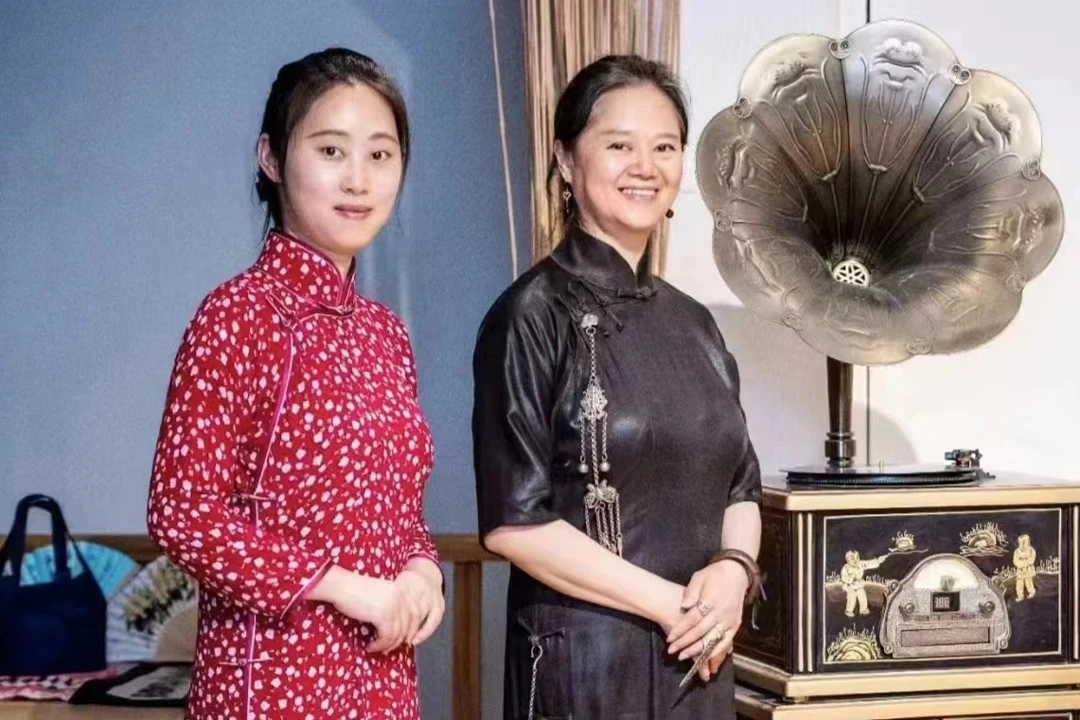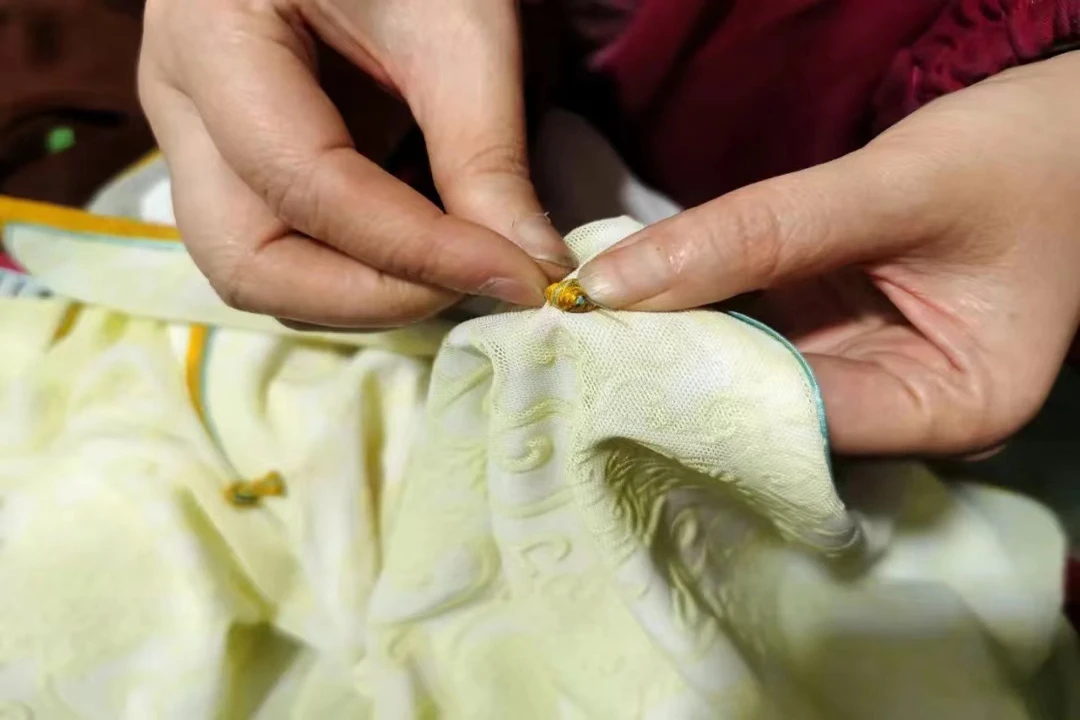In an old alley in the Tianxing Bridge area of Shapingba District, Chongqing, the Junlin Century Cheongsam Studio quietly “hides” among the buildings. The antique eight-immortal table, century-old poplar wood bed, along with the side table, screen, five-drawer cabinet, and long bench, together with the exquisite cheongsams, create a classic scene reminiscent of a traditional Chinese mansion.
Zhang Yumei is cutting a cheongsam on the workbench. From selecting the fabric, taking measurements, cutting, to hand-sewing and embroidering, every step is done with a leisurely pace.
“I believe that the cheongsam is a garment that can make every Chinese woman look beautiful when wearing it. It has a warmth to it,” says Zhang Yumei, the fourth-generation inheritor of Junlin Century Cheongsam.
The studio displays hundreds of meticulously crafted cheongsams in various fabrics such as brocade, silk, linen, and cotton, with different styles like high collars, diagonal lapels, and slits, adorned with rolled edges, beading, frog buttons, and embroidery. These cheongsams, each with its unique style, texture, and design, are the works of Zhang Yumei and her colleagues.
Having a passion for traditional culture since childhood, Zhang Yumei studied fashion design in college. After graduation, she came to the Junlin Cheongsam Studio upon the recommendation of her senior fellow apprentice and began learning how to make a cheongsam.
“When I first started working at the studio, it was very challenging. I had to be an apprentice for two to three years, cooking and doing odd jobs. At that time, I didn’t have the opportunity to systematically learn how to make a cheongsam,” Zhang Yumei recalls. Whenever the master craftsmen in the studio started making cheongsams, she would stand beside them and observe.
As one of the four famous Chinese embroidery styles, Shu embroidery is an essential decorative element in Zhang Yumei’s cheongsam designs. Its bright and delicate colors, combined with exquisite and meticulous stitching techniques, give the cheongsams a unique charm that is highly favored by customers.
“I believe that the cheongsam is a garment that can make every Chinese woman look beautiful when wearing it. It has a warmth to it, and this is what our national clothing should be,” Zhang Yumei affirms.

As a century-old cheongsam shop with a four-generation legacy, Junlin Cheongsam has witnessed the transformation of Chongqing from a celebrity-filled wartime capital to a thriving, fashionable metropolis. It has also seen the cheongsam’s prosperity, decline, and revival.
To ensure the continued development of the traditional craftsmanship and the century-old legacy of Junlin Cheongsam, Zhang Yumei spends her free time reading numerous Chinese and Western fashion magazines and books, studying contemporary fashion culture. She believes that only by finding the “taste of modern people” and incorporating elements that young people like into the design of cheongsams can more young people be attracted to understand and appreciate the cheongsam, intangible cultural heritage, and traditional craftsmanship.
Zhang Yumei’s dedication to preserving and innovating the art of cheongsam-making is a testament to the resilience and adaptability of traditional Chinese craftsmanship. By carefully studying the preferences of modern consumers and incorporating contemporary design elements, she is bridging the gap between the past and the present, ensuring that the cheongsam remains relevant and appealing to younger generations.
This approach not only safeguards the cultural heritage of the cheongsam but also breathes new life into the craft, allowing it to evolve and thrive in the 21st century. Zhang Yumei’s efforts to modernize the cheongsam while staying true to its essence demonstrate the potential for traditional arts to coexist and flourish alongside contemporary fashion trends.
Moreover, by showcasing the intricacy and beauty of Shu embroidery in her cheongsam designs, Zhang Yumei is also playing a crucial role in preserving and promoting this ancient Chinese embroidery technique. The incorporation of Shu embroidery not only enhances the aesthetic appeal of the cheongsams but also helps to raise awareness and appreciation for this important aspect of China’s cultural heritage.
The story of Junlin Cheongsam Studio and Zhang Yumei’s dedication to her craft also highlights the significance of small, family-owned businesses in preserving traditional arts and crafts. These establishments often serve as the last bastions of centuries-old techniques and knowledge, passed down from generation to generation through apprenticeships and hands-on learning.
However, the survival of these businesses and the continuation of their crafts are not without challenges. In an era of mass production and fast fashion, the slow, meticulous process of creating a handmade cheongsam can seem impractical and uneconomical. Zhang Yumei and her colleagues face the constant pressure of adapting to changing market demands while maintaining the integrity and quality of their work.
Despite these difficulties, the passion and perseverance of artisans like Zhang Yumei offer hope for the future of traditional craftsmanship. By embracing innovation and finding ways to make their craft relevant to contemporary audiences, they are ensuring that the legacy of the cheongsam and other traditional arts will endure for generations to come.
Furthermore, the preservation of traditional craftsmanship is not only important for its cultural value but also for its potential to contribute to sustainable and ethical fashion practices. In a world increasingly concerned with the environmental and social impact of clothing production, the handmade, locally-sourced, and high-quality nature of traditional garments like the cheongsam offers a compelling alternative to the fast fashion model.
By supporting artisans like Zhang Yumei and choosing to invest in well-crafted, timeless pieces, consumers can play a part in promoting a more sustainable and responsible fashion industry. This, in turn, can help to create a virtuous cycle, where the demand for traditional craftsmanship encourages more young people to pursue careers in these fields, ensuring the continuation of these valuable skills and knowledge.
In conclusion, the story of Zhang Yumei and the Junlin Cheongsam Studio is a powerful reminder of the importance of preserving and promoting traditional craftsmanship in the face of a rapidly changing world. Through their dedication, innovation, and unwavering commitment to quality, artisans like Zhang Yumei are not only keeping the legacy of the cheongsam alive but also contributing to a more sustainable, ethical, and culturally rich fashion landscape.
As we move forward, it is crucial that we continue to support and celebrate these guardians of our cultural heritage, recognizing the value of their work and the vital role they play in shaping our understanding of beauty, identity, and tradition. By embracing the cheongsam and other traditional arts, we not only pay homage to our past but also invest in a future where craftsmanship, sustainability, and cultural diversity can thrive.


